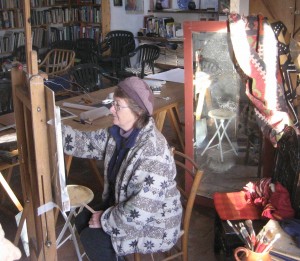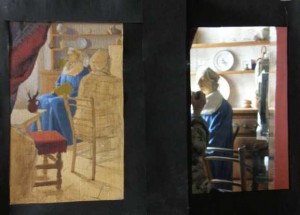Since the publication of “Vermeer’s Camera” by Philip Steadman it has become accepted that Vermeer used a camera obscura. Steadman is an architect by training he is most knowledgeable about the mathematics of drawing. His book is a very thorough review of the literature on Vermeer. He rightly opts for Lawrence Gowing as the leading expert. Many may not know that Gowing was for the first half of his career, a fine tonal painter. From his book it is perfectly clear that Vermeer was his role model.
Gowing is very much more in touch with what a painter gets from Vermeer than Steadman. Gowing writes “the optical basis of his method is most visible not in the planning…….so much as in the tonal recording of certain passages” later he describes Vermeer’s work “as statements of light purged of any other content”. It is this essence of Vermeer that “Vermeer’s Camera” fails to address. The camera obscura would be a positive handicap in achieving these qualities. We can be quite certain that Gowing would have taken one look at the “dark images” the camera provided and turned away disappointed.
Most recent authorities agree that the camers obscura was used, and I am certainly persuaded that it was but my interpretation is different to Steadman’s. The eye automatically refocuses. However determinedly one may try to observe objects out of focus one fails to see anything approaching Vermeer’s out of focus effects, which must be deliberate.
Steadman shows that Vermeer could have been in touch with the most advanced optical experiments of his day. The anatomy of the eye was sufficiently understood to know that it, like the camera, must also go out of focus but only the camera allows one to study light in this condition. This is Vermeer’s prime use of the camera. The planning stage could equally well have been done with Durer’s screen and fixed eye point or Alberti’s net, or Brunelleschi’s constructional method, as Steadman readily admits.
Here we are experimenting with an arrangement of mirrors which is cryptically described in Vermeer’s largest painting “The Art of Painting”. The interpretation was first proposed by Willenski. I arrived separately at the same conclusion through my interest in artists’ use of mirrors and wrote it up in 1980 after conducting the simple experiment which Willenski failed to make. It works. Incidentally this arrangement can also explains the geometry of the results.
Essentially we are pursuing Willenski’s line of thought into the practice. Anne Shingleton, who is a painter trained in the old school (by Simi) and who has 30 years experience of painting light, is in the driving seat.

Here in the library of The Centro d' Arte Verrocchio we see Anne sitting between two mirrors. The big one behind her is somewhat narrower than that used by Vermeer. It is 53x130cm with generous bevels and a frame, which rests on the floor. The plane of the mirror is very nearly parallel to the end wall. The smaller one on her easel, for simplicity is masked off at 26 high x 16cm. wide. The angle between the two mirrors is approx 30 degrees.
Her first reaction on looking at the image in the second mirror on the painting easel was. “Wow, I would like to try it, it seems such a good idea”. She went back to her studio and immediately produced a painting with the method, she said “ the experience has been of great value and has made me look at Vermeer’s work with a completely different eye. The main advantages of working in this way are :-
1. You see the whole composition in the second mirror and so you can move objects around to achieve a pleasing colour and tonal balance before you start.
2. The image in the mirror is conveniently small in comparison with reality, making it easier to judge the balances within the composition.
3. The image can be traced off the mirror, or as it’s viewed sight size can therefore easily be drawn on to a canvas.
4. Above all the tonal range can be analysed much more easily because the intensity of the light is reduced by being reflected off two mirrors and is not thrown out of balance. (Two 17thC mirrors would have reduced the light still further.)
5. The objects are quite far away so the details are more difficult to observe but for a painter this is a definite advantage as the this helps perception of the main light and dark areas.
6. The heavy drape in the immediate foreground also helps the artist judge the more subtle area of light by providing the darkest darks and sometimes the richest colours for comparison within the picture frame.

The artist's task is to mentally compress and adjust this tonal range down a series of tonal notches to that which his paints can span to produce the same scene, maintaining all the time the delicate relationships between all the middle tones. Here we see the painting (left) and the reduced image in the second mirror (right).
Judging the tones of a scene and converting them into paint for a painting is a skill that requires much practice to master. There are many approaches. When we look at a scene with the naked eye we see the lightest areas and the darkest areas and the rest is made up of all the multitude of tones between. (Our eyes also adapt in many ways, for example by changing the width of the pupil, allowing us to work with a really wide tonal range.) Our eyes are wonderful machines to perceive light.
Simply put, the task of the painter is to trick the eye into seeing the same scene, but reproduced using the darkest paint, black, to represent the darkest dark, and the lightest paint, white, to represent the lightest light, and to reconstruct all the tones in-between. Looking at a scene with the naked eye it is quite difficult to imagine, for example that the bright shine on a white, porcelain jug, would have to represent the white pigment on your palette, when the actual white pigment held up on a palette knife in front of the jug actually compares in tone more closely to the lit side of the jug. Thus, the artist’s task is to mentally compress and adjust this tonal range down a series of tonal notches to that which his paints can span to produce the same scene, maintaining all the time the delicate relationships between all the middle tones. The visual reality is reconstructed in painted areas of tone that balance well with each other on the canvas and create the illusion of the same scene. Mirrors which help reduce the light intensity are certainly a useful tool here.
To judge all the light and dark values the artist uses a palette on which to mix up the colours. The colours are arranged around the edge. It is portable because the palette must be seen in the same light that the canvas is lit by. I do not think an artist could look at a very lowlight image in a dark box and then return to mix up the colours in the daylight outside the box. It would be a very impractical way of working, since for each mix you would be comparing many times, and there would be a pause each time as your eyes adjusted to the large change in light intensity. This is another advantage of the two mirrors over the camera obscura.
I have recently studied an image through a camera obscura and did not find it remotely inviting to paint. Steadman’s explanation of the necessary technique with blinds sounds too complicated by comparison with the ease of this mirror method.
The first days work was spent in arranging the composition using Vermeer’s colour schemes as a guide. The back mirror is only 3.10m from the wall. A remarkably small studio space. And this is perhaps the strongest argument against Steadman who requires a palatial studio for Vermeer’s camera. Could Vermeer, who was driven to paying his baker’s bill with a painting and died in debt, possibly have afforded such a studio? Think of the heating bills in Holland in the winter.
PICTURES COMING SHORTLY